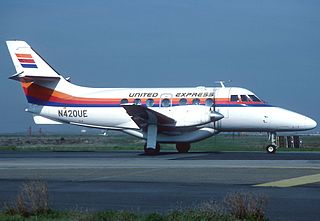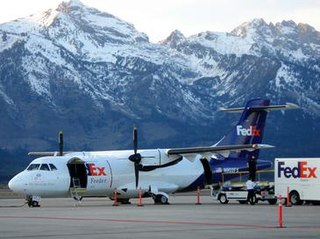
The Hawker 800 is a mid-size twinjet corporate aircraft. It is a development of the British Aerospace 125, and was assembled by Hawker Beechcraft.

United Airlines Flight 585 was a scheduled passenger flight on March 3, 1991, from Denver to Colorado Springs, Colorado, carrying 20 passengers and 5 crew members on board. The plane experienced a rudder hardover while on final approach to runway 35 at Colorado Springs Municipal Airport, causing the plane to roll over and enter an uncontrolled dive. All 25 people on board the Boeing 737 were killed on impact.

China Airlines Flight 140 was a regularly scheduled passenger flight from Chiang Kai-shek International Airport to Nagoya Airport in Nagoya, Japan.

On October 14, 2004, Pinnacle Airlines Flight 3701 crashed near Jefferson City, Missouri, while flying from Little Rock National Airport to Minneapolis–Saint Paul International Airport. The two pilots, the only occupants, were killed. Federal investigators determined the crash was due to the pilots' unprofessional behavior and disregard for training and procedures.

Gulf Air Flight 072 (GF072/GFA072) was a scheduled international passenger flight from Cairo International Airport in Egypt to Bahrain International Airport in Bahrain, operated by Gulf Air. On 23 August 2000 at 19:30 Arabia Standard Time (UTC+3), the Airbus A320 crashed minutes after executing a go-around upon failed attempt to land on Runway 12. The flight crew suffered from spatial disorientation during the go-around and crashed into the shallow waters of the Persian Gulf 2 km (1 nmi) from the airport. All 143 people on board the aircraft were killed.

Comair Flight 3272 was a Comair flight from Cincinnati to Detroit on Thursday, January 9, 1997. While on approach for landing, the Embraer EMB 120 Brasilia aircraft crashed nose-down 18 miles (29 km) southwest of Detroit Metropolitan Wayne County Airport at 15:54 EST, killing all 29 people on board.
Portage County Airport, also known as Portage County Regional Airport, is a public use airport in Portage County, Ohio, United States. It is owned by the Portage County Board of Commissioners and located three nautical miles (6 km) north of Ravenna, in Shalersville Township. This airport is included in the National Plan of Integrated Airport Systems for 2011–2015, which categorized it as a general aviation facility.

Alliance Air Flight 7412 was a scheduled Indian domestic passenger flight from Calcutta to Delhi, operated by Indian regional airliner Alliance Air. On 17 July 2000, while on approach to its first stopover in Patna, the Boeing 737-2A8 operating the route nose-dived and crashed into a residential area in Patna, killing 60 people including 5 on the ground.

KLM Cityhopper Flight 433 was a Saab 340B, registered as PH-KSH, which crashed during an emergency landing on 4 April 1994 and killing 3 occupants, including the captain. Flight 433 was a routine scheduled flight from Amsterdam, the Netherlands, to Cardiff, Wales. The accident was caused by inadequate pilot training and a faulty sensor, leading to loss of control during go-around.

Turkish Airlines Flight 634 was a scheduled domestic passenger flight from Istanbul Atatürk Airport to Diyarbakır Airport in southeastern Turkey. On 8 January 2003 at 20:19 EET, the aircraft operating the flight, a British Aerospace Avro RJ100, struck the ground on final approach approximately 900 metres (3,000 ft) short of the runway threshold during inclement weather conditions. In the following collision with a slope, a post-crash fire broke out, killing 75 of the 80 occupants, including the entire crew. This is the deadliest aviation accident to involve the BAe 146.

Colgan Air Flight 3407 was a scheduled passenger flight from Newark, New Jersey, US to Buffalo, New York, US on February 12, 2009. Colgan Air staffed and maintained the aircraft used on the flight that was scheduled, marketed, and sold by Continental Airlines under its Continental Connection brand. The aircraft, a Bombardier Q400, entered an aerodynamic stall from which it did not recover and crashed into a house at 6038 Long Street in Clarence Center, New York at 10:17 pm EST, killing all 49 passengers and crew on board, as well as one person inside the house.

South African Airways Flight 228 was a scheduled flight from Johannesburg, South Africa, to London, England. The Boeing 707-300C operating the flight, which was only six weeks old, flew into the ground soon after take-off after a scheduled stopover in Windhoek, South West Africa on 20 April 1968. Five passengers survived, while 123 people died. The subsequent investigation determined that the accident was attributable largely to pilot error; the manufacturer subsequently also recognised the lack of a ground proximity warning system in its aircraft. The accident is the deadliest aviation accident to date in Namibia.

United Express Flight 2415 was a regularly scheduled flight in the northwest United States from Seattle to Pasco, Washington, operated using a BAe Jetstream 31. Late on Tuesday, December 26, 1989, Flight 2415 crashed while attempting to land at Pasco's Tri-Cities Airport, killing both pilots and all four passengers aboard.

Empire Airlines Flight 8284 was a cargo flight operated by Empire Airlines for FedEx Feeder from Fort Worth Alliance Airport to Lubbock Preston Smith International Airport, Texas. On January 27, 2009, it crashed on final approach to its destination. Both crew members survived with minor injuries but the aircraft was written off.

American International Airways Flight 808 was a cargo flight operated by American International Airways that crashed on August 18, 1993 while attempting to land at Leeward Point Field at the Guantánamo Bay Naval Base in Cuba. All three crew members on board survived with serious injuries.

LAN Chile Flight 1069 was a passenger flight which suffered an accident at Puerto Williams Airport in Chile on February 20, 1991. The regional flight from Punta Arenas Airport, approximately 300 kilometres (190 mi) distant, overran the runway on arrival at Puerto Williams, killing 20 of the 66 passengers. All 6 crew members survived.

Air Transport International Flight 782 was a ferry flight from Kansas City International Airport in Missouri to Westover Metropolitan Airport in Springfield, Massachusetts using a Douglas DC-8-63 with one of its 4 engines inoperative. On February 16, 1995, the aircraft failed to take off from Kansas City, overran the runway, and crashed. All three flight crew members, the only occupants on board, were killed. The cause was deemed to be improper training, which resulted in the crew failing to understand a three-engine takeoff procedure. In addition, the Federal Aviation Administration (FAA)'s oversight of rest regulations and the airline were both poor.

Delta Air Lines Flight 9877 was a crew training flight operated on a Douglas DC-8. On March 30, 1967, it lost control and crashed into a residential area during a simulated engine-out approach to Louis Armstrong New Orleans International Airport.

Philippine Air Lines Flight 345 was a domestic flight operated by Philippine Air Lines that crashed on approach to Mactan–Cebu International Airport, Cebu.

On May 15, 2017, a Learjet 35A business jet operated by Trans-Pacific Air Charter crashed while on approach to Teterboro Airport, killing both pilots, the only two occupants on board. The aircraft, flying a repositioning flight from Philadelphia International Airport in Philadelphia, Pennsylvania, to Teterboro Airport in Teterboro, New Jersey, was flying a circle-to-land approach to land on Runway 1 when it stalled and crashed into a commercial building and a parking lot. The investigation, conducted by the National Transportation Safety Board, determined several factors that led to the crash. The captain of the flight allowed the underqualified first officer to be the pilot flying, which was directly against company procedures. Neither flight crew member conducted an approach briefing, which led to a loss of situation awareness and a failure to maintain proper altitude during the approach. During the circle-to-land maneuver — which was conducted on an unstabilized approach and not in guidance with air traffic control instructions – the captain was focused on aligning the aircraft with the runway rather than indications in the cockpit that showed the airspeed was too slow. This resulted in an aerodynamic stall at such a low altitude that the crew was unable to recover.






















